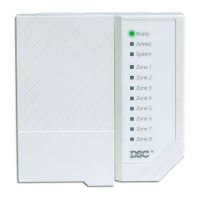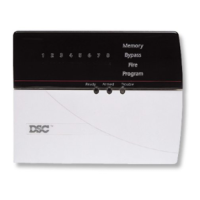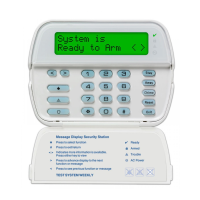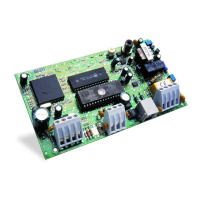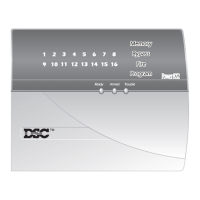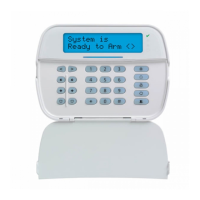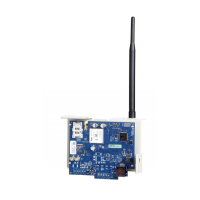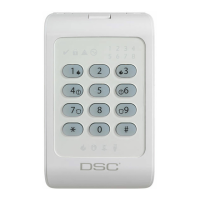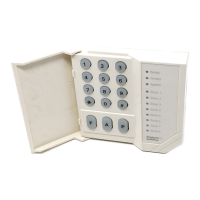24
Minutes/Days allows you to select whether the Land Line Test
Transmission cycle will be counted in minutes or days. If you
have selected the test transmission cycle to be in minutes, the
Test Transmission Time of Day counter will not apply.
NOTE:If you have selected the Land Line Test Transmission in
Minutes option, do not program the test transmission cycle to
be less than 10 minutes.
NOTE:The GSM Test Transmission can only be programmed
in days.
If you program the test transmission cycle for a longer period
of time than it was programmed for previously, the system will
wait the original time period before the next test transmission
is sent, and then begin reporting with the new interval.
The panel can also send a test for the GSM1000 Cellular Com-
municator, if used. If the GSM1000 Test Transmission Code
is programmed, the panel will send a cellular test at the inter-
val programmed in the GSM Test Transmission Cycle.
Users can also generate a communicator test. If the System
Test Reporting Code is programmed, the panel will send the
signal when the System Test keypad command is entered.
(See ‘[*][6] User Functions’ on page 10.)
Test Transmission Reporting Codes . . . . . . . . . Section [352]
Test Transmission Time of Day . . . . . . . . . . . . . Section [371]
Test Transmission Cycles . . . . . . . . . . . . . . . . . Section [370]
Land Line Test Transmission M/D . . . . . . . . Section [702]: [3]
5.16 Transmission Delay
If the transmission delay zone attribute is selected for a given
zone, the panel will delay reporting an alarm for that zone for
the number of seconds programmed for the Transmission
Delay Time. If the panel is disarmed before the delay time
expires, the panel will not report the event.
Transmission Delay Time. . . . . . . . . . . . . . . . . . Section [370]
5.17 Fire, Auxiliary and Panic Keys
The emergency keys are available on all keypads. These keys
must be pressed and held for two seconds before they will
activate. This two second delay is designed to help prevent
accidental activation.
If the [F] / Key option is enabled, when the Fire keys are
pressed and held for two seconds, the panel will activate the
alarm output following the option programmed in section
[013]: [8] (see section 5.14 ‘Bell’ on page 23). The alarm out-
put will sound until a code is entered or until the bell cut-off
time expires. Communication of the signal to central station is
immediate.
If the [A] / Key is pressed and held for two seconds, the
panel will sound the keypad beeps three times to verify activa-
tion. The panel will beep the keypad ten times rapidly when a
kissoff is received, to verify communication to the central station.
If the [P] / Key is pressed and held for two seconds, the
panel will immediately communicate the signal to central station.
If [P] Key Audible Bell and Buzzer option is enabled, when a
user presses the [P] / key, the keypad will beep three times
and the panel will activate the alarm output until an access
code is entered or the bell cut-off expires. If the option is dis-
abled, the Panic alarm will be completely silent.
Each LCD keypad may be programmed to have the [F], [A], &
[P] keys enabled or disabled. Please refer to Appendix
B: ‘Programming LCD Keypads’ on page 46.
NOTE:The Fire, Auxiliary, Panic keys will operate even if Keypad
Blanking is active (See 5.23 ‘Keypad Blanking’ on page 26.)
[F] Key Enable . . . . . . . . . . . . . . . . . . . . . . Section [015]: [1]
[P] Key Audible Bell and Buzzer . . . . . . . . Section [015]: [2]
5.18 Arming/Disarming Options
If the Quick Arm option is enabled, the panel can be armed
without an access code by entering [*][0] or by pressing the
Stay or Away function key. If the Quick Arm option is disabled,
users will need to enter an access code after pressing a func-
tion key.
The Quick Exit option, if enabled, will allow someone to leave
an armed premises through a Delay type zone without having
to disarm and re-arm the system. See ‘[*][0] Quick Exit’ on
page 11.
Enable the Arm/Disarm Bell Squawk option to have the
panel squawk the alarm output once upon arming and twice
upon disarming. If an alarm is in memory, when the panel is
disarmed the bell will sound three pairs of disarm squawks.
NOTE: If you enable the Bell Squawk on Arming/Disarming (sec-
tion [014], option [1]), the bell will sound arm/disarm bell squawks
for all access codes, regardless of the programming for attribute
[7]. See ‘[*][5] Programming Access Codes’ on page 10.
Enable both the Squawk on Away Arming/Disarming Only
and the Arm/Disarm Bell Squawk options to have the panel
squawk the bell only when the system is away armed or dis-
armed.
The Opening After Alarm Keypad Ringback option will cause
the keypad to beep 8 times rapidly after the Opening After
Alarm reporting code has been successfully transmitted to the
central station. The Opening After Alarm Bell Ringback
option will cause the panel to squawk the bell 8 times rapidly
after the Opening After Alarm reporting code has been suc-
cessfully transmitted to the central station.
NOTE: If the panel is armed using the Stay function key, or by
entering [*][9][access code], there will be no bell squawks during
entry and exit delays, except for the arm/disarm bell squawks.
Closing Confirmation, if enabled, will cause the keypad to
beep 8 times rapidly after the closing reporting code has
been successfully transmitted to central station.
If the Bypass Status Displayed While Armed option is cho-
sen, the Bypass light will be ON while the system is armed to
indicate that there are bypassed zones.
If the AC/DC Inhibit Arming option is enabled, the panel will
not arm if there is an AC or DC (battery) trouble present on the
system. Arming will not be allowed until the AC or battery trou-
ble is cleared. If no AC or battery trouble is currently present,
when a user attempts to arm the system, the panel will do an
automatic battery test of the main panel and modules that
support a backup battery. If the battery is good, the system
will arm. If the battery is bad, the system will not arm.
If the AC/DC Inhibit Arming option is disabled, the panel will
not do an automatic battery test when arming is attempted
and the user will not be prevented from arming the system
when there is an AC or battery trouble.
If you enable the WLS Key Does Not Use Access Codes
option, the disarm button will work on wireless keys which
have not been assigned access codes. Wireless keys can
only be assigned access codes when used with PC5132 v3.0
or higher.

